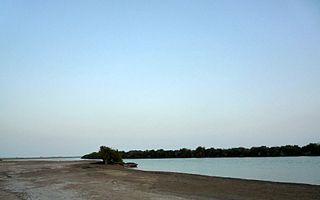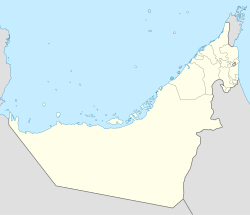Sheikh Sultan bin Saqr Al Qasimi (1781–1866) was the Sheikh of the Qawasim and ruler variously of the towns of Sharjah and Ras Al Khaimah, Jazirah Al Hamra and Rams, all Trucial States in their time and now part of the United Arab Emirates. Briefly a dependent of the first Saudi Kingdom, his rule over Ras Al Khaimah ran from 1803–1809, when he was deposed by order of the Saudi Amir and restored in 1820, going on to rule until his death in 1866 at the age of 85. He was Ruler of Sharjah from 1814–1866, with a brief disruption to that rule in 1840 by his elder son Saqr. He was a signatory to various treaties with the British, starting with the General Maritime Treaty of 1820 and culminating in the Perpetual Maritime Truce of 1853.

Ajman is the capital of the emirate of Ajman in the United Arab Emirates. It is the fifth-largest city in UAE after Dubai, Abu Dhabi, Sharjah and Al Ain. Located along the Persian Gulf, it is engulfed by the larger emirate of Sharjah in territory.

Kalba is a city in the Emirate of Sharjah in the United Arab Emirates (UAE). It is an exclave of Sharjah lying on the Gulf of Oman coast north of Oman. Khor Kalba, an important nature reserve and mangrove swamp, is located south of the town by the Omani border.
Masfout is a village that forms part of the eponymous exclave of Masfout in Ajman, one of the seven emirates forming the United Arab Emirates. It is surrounded by Ras Al Khaimah, the Dubai exclave of Hatta and Oman. It is only accessible from Ajman itself by crossing territories of Sharjah, Ras Al Khaimah, and Oman.

Al Hamriyah is the name of a coastal settlement of Sharjah on the northern perimeter of the United Arab Emirates. It is one of nine municipalities of the emirate, and is wedged between the emirates of Ajman (south) and Umm Al Qawain (north). It is notable for its lagoon popular with pleasure boaters and jet skiers as well as local fishermen who moor here, as well as storing and repairing both rope and wire mesh fishing nets.
Sheikh Salim bin Sultan Al Qasimi was Ruler of Sharjah, a Trucial State and now one of the United Arab Emirates, from 1868–1883. His rule was unusually tumultuous and marked by intrigue, the secession of Sharjah's dependencies and constant conflict. He was also briefly the Ruler of Ras Al Khaimah from 1868–1869 and its wali, or governor, from 1908–1919.
Sheikh Saqr bin Khalid Al Qasimi (1883–1914) was the Ruler of Sharjah, a Trucial State and now one of the United Arab Emirates, from 1883–1914. He took control over Sharjah in a coup during the absence of his uncle, Salim bin Sultan Al Qasimi, and ruled both Sharjah and, from 1900 until his death in 1914, Ras Al Khaimah.
Sheikh Khalid bin Ahmad Al Qasimi was the Ruler of Sharjah, a Trucial State and now one of the United Arab Emirates, from 1914–1924 and Ras Al Khaimah from 1914–1921. He acceded on the death of Saqr bin Khalid Al Qasimi. His rule was tumultuous and unpopular, marked by internecine conflicts and public discontent and saw the final disintegration of the Al Qasimi's joint rule over Sharjah and Ras Al Khaimah. Deposed as Ruler of Sharjah in 1924, he went on to become ruler of Dhaid and Kalba and a highly influential figure in the Shamaliyah.
Sheikh Sultan II bin Saqr Al Qasimi was the Ruler of Sharjah, a Trucial State and now one of the United Arab Emirates, from 1924 to 1951. His father having ceded the rule of Sharjah to Khalid bin Ahmad Al Qasimi, Sultan found himself dispossessed and married the daughter of Abdulrahman bin Shamsi, the headman of Al Heera. Buoyed by Khalid's unpopularity and Abdulrahman's force of personality and arms, Sultan deposed Khalid and became Ruler of Sharjah. However, he found the interior of the country dominated by Bedouin tribes and the East coast increasingly dominated by the former Ruler, Khalid bin Ahmad, leaving Sultan the effective ruler of a cluster of coastal settlements, many of which constantly tried to secede from his rule. He is cited as having presided over a low ebb in the power of the Al Qasimi, formerly a powerful maritime federation.
Sheikh Sultan bin Salim Al Qasimi was Ruler of Ras Al Khaimah from 1921–1948. His long and turbulent rule was characterised by internecine family and tribal disputes and he was finally removed as Ruler in a 1948 coup.
Sheikh Hamad bin Ibrahim Al Mualla was Ruler of Umm Al Quwain from 1923 to 1929, one of the Trucial States which today forms part of the United Arab Emirates (UAE).
Sheikh Ali bin Abdullah Al Mualla was Ruler of Umm Al Quwain from 1853–1873, one of the Trucial States which today form the United Arab Emirates (UAE).
The Bani Qitab is a tribe of the United Arab Emirates (UAE). The singular form of the name, Al Ketbi, is a common family name in the Northern UAE today. Consisting of a settled southern section and a nomadic northern section, the tribe was long influential in the conduct of affairs in the interior of the Trucial States. The Northern branch mostly settled in the inland towns of Dhaid and Al Falayah.
The Na'im is an Arab tribe in the United Arab Emirates. The tribe is also present in other gulf countries.
Humaid bin Abdulaziz Al Nuaimi was Ruler of Ajman, one of the Trucial States which today form the United Arab Emirates (UAE), from 1910–1928. His rule was marked by a running conflict with the Al Bu Shamis and their charismatic Sheikh, Abdulrahman bin Muhammad Al Shamsi.
Sheikh Hamad bin Abdullah Al Sharqi was the first recognised leader of the Al Sharqi Ruling family of Fujairah, one of the Trucial States and today one of the United Arab Emirates (UAE). He led Fujairah in a number of insurrections against Al Qasimi rule, presiding over a turbulent time when the emirate was practically independent but denied recognition of status as a Trucial State in its own right by the British.
Sheikh Tahnun bin Shakhbut Al Nahyan was the Ruler of Abu Dhabi from 1818–1833. Having deposed his brother Muhammad bin Shakhbut Al Nayhan with his father's support, he ruled in his father's name. Under Tahnun, Abu Dhabi became a Trucial State in 1820, eventually becoming the capital of the United Arab Emirates (UAE).

Ajman Fort is a double-storey traditional rock, coral and mudbrick fortification in the centre of the city of Ajman in the United Arab Emirates (UAE). Its construction is thought to date back to the late 18th century and it is claimed the fort's barjeel, or wind tower, is the oldest such structure in the UAE.

Bithnah Fort is a traditional double story rock, coral and mudbrick fortification located in the Wadi Ham, near the village of Bithnah in Fujairah, United Arab Emirates. The fort has played a significant role in the history of the Emirates, particularly in the emergence of Fujairah as an independent emirate in the early 20th century. With a controlling position overlooking the Wadi Ham, the fort replaced an Iron Age fortification.
Abdulrahman bin Muhammad Al Shamsi was the Sheikh, or head man, of the township of Al Heera, today a suburb of Sharjah in the United Arab Emirates. A highly influential and often divisive figure in regional politics during the early 20th century in the Trucial States, he was referred to by one British Political Resident as ‘a stormy petrel of the Trucial Coast, a man feared by everyone in and around Sharjah’.







